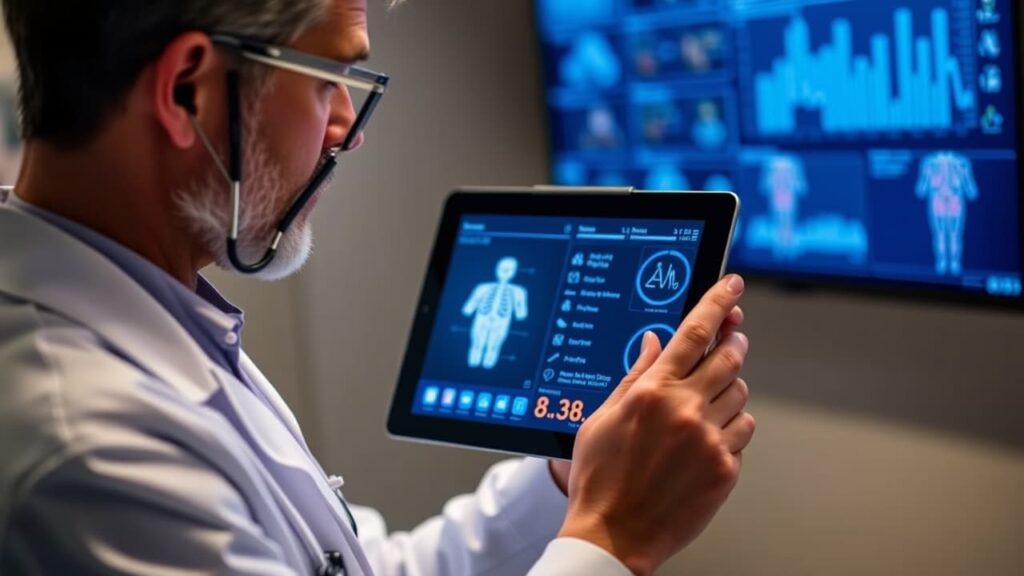The intersection of artificial intelligence (AI) and the Fast Healthcare Interoperability Resources (FHIR) standard is transforming the healthcare industry. As we approach 2025, understanding the nuances of FHIR and its adoption is crucial for healthcare providers aiming to enhance data exchange and patient care. This article delves into FHIR’s significance in healthcare, the benefits it offers, and the challenges faced in its implementation, all while highlighting the trend of integrating AI into these processes.
Understanding FHIR in Healthcare

What is FHIR?
FHIR, or Fast Healthcare Interoperability Resources, is a pivotal standard developed by Health Level Seven International (HL7) that revolutionizes electronic health record (EHR) systems and healthcare data exchange. By leveraging modern web technologies such as RESTful APIs, FHIR facilitates seamless data sharing across various healthcare systems. Its modular design allows healthcare providers to utilize discrete resources representing patient records, medication histories, and other essential healthcare data. This flexibility in implementation not only enhances interoperability but also supports the growing demand for digital health solutions in today’s healthcare landscape.
Key Benefits of FHIR Adoption
The adoption of FHIR brings numerous advantages to the healthcare sector, chief among them being improved data interoperability. By standardizing healthcare data exchange, FHIR enables seamless communication among disparate healthcare systems, thus contributing to better-informed clinical decisions and improved patient outcomes. Healthcare providers can harness FHIR to gain real-time access to patient data, allowing them to respond swiftly to patient needs. Additionally, the modularity of FHIR allows organizations to tailor its implementation according to their specific requirements, making it a versatile solution that can accommodate a wide range of applications within the healthcare system.
Challenges in Implementing FHIR
Despite its promising benefits, implementing FHIR is not without challenges. Technical complexity often poses significant barriers, especially for smaller healthcare providers that may lack expertise in data management and API integration. Privacy and security concerns also emerge as sensitive patient data is exchanged across systems, necessitating stringent measures to ensure data privacy. Resource constraints in regions with limited healthcare budgets can further complicate the adoption of FHIR. Additionally, variability in standards and the need for regulatory compliance add layers of complexity to the FHIR implementation process, as different regions may interpret the FHIR standard in diverse ways. Amid these challenges, healthcare organizations are also moving towards incorporating VPN technologies, such as VPN Unlimited, to ensure secure data transfer and safeguard patient information within FHIR networks.
Trends Driving FHIR Adoption

Current Trends in Healthcare Data Exchange
Current trends in healthcare data exchange highlight the growing importance of interoperability within the healthcare industry. Regulatory frameworks, particularly in the United States and Europe, are increasingly mandating the use of interoperable systems, leading to a surge in FHIR adoption. The adoption of FHIR is bolstered by the rise of digital health technologies, such as telemedicine and mobile health applications, which necessitate standardized data exchange mechanisms. Moreover, the integration of FHIR into various healthcare sectors, including pharmaceuticals and public health, reflects its versatility and adaptability in meeting diverse healthcare needs. As these trends continue to evolve, the urgency to adopt FHIR as part of a comprehensive healthcare system becomes more pronounced, ensuring efficient data sharing and improved patient outcomes.
Influence of AI on FHIR Adoption
Artificial intelligence (AI) is significantly influencing FHIR adoption by enhancing data analysis capabilities and improving decision-making processes within healthcare providers. AI algorithms can process large volumes of FHIR-standardized data quickly, enabling healthcare professionals to derive actionable insights from intricate patient information. This synergy between AI and FHIR fosters the development of predictive analytics tools that can anticipate patient needs, optimize care delivery, and enhance clinical trial outcomes. As AI technologies continue to evolve, their integration with FHIR will likely accelerate the adoption of interoperable systems across the healthcare landscape, supporting the future of FHIR and emphasizing the importance of data interoperability in clinical settings.
Impact of Digital Health on FHIR Implementation
The expansion of digital health technologies has a profound impact on FHIR implementation, as telemedicine, mobile health applications, and electronic health records (EHRs) increasingly rely on FHIR to facilitate seamless data exchange. The COVID-19 pandemic has further accelerated this trend, prompting many healthcare organizations to adopt FHIR to enhance their digital health capabilities and ensure efficient data management. As digital health continues to grow, the need for standardized, interoperable systems becomes more critical, solidifying FHIR as a cornerstone of future healthcare delivery. The ongoing support for FHIR adoption by national coordinators for health information technology underlines its importance in creating a cohesive healthcare data ecosystem that prioritizes patient data privacy while promoting improved health outcomes.
Data Interoperability and FHIR
Significance of Data Interoperability
Data interoperability is a cornerstone of modern healthcare, facilitating seamless data exchange across various systems. This capability is crucial as it ensures that patient information is accessible at all times, thereby improving care coordination and enhancing patient outcomes. Healthcare providers can leverage comprehensive patient data to make informed decisions, ultimately reducing the likelihood of medical errors and avoiding redundant procedures. Fast Healthcare Interoperability Resources (FHIR) plays an instrumental role in achieving this interoperability by offering a standardized framework for data sharing. As healthcare systems continue to evolve and integrate, the significance of data interoperability will only amplify, solidifying FHIR’s position as an essential element in contemporary healthcare practices.
How FHIR Enables Better Data Exchange
FHIR enhances data exchange by standardizing healthcare information into modular resources that can be effortlessly integrated into various healthcare systems. This standardization simplifies the sharing of healthcare data, allowing providers to access and utilize patient information more efficiently. By employing modern web technologies such as RESTful APIs, FHIR facilitates real-time data access and interoperability, ensuring that healthcare professionals can quickly obtain the most up-to-date patient data. This capability is particularly vital in emergency situations, where timely access to health records can significantly influence clinical outcomes. Through FHIR, healthcare providers are empowered to improve data management and streamline processes, ultimately leading to better patient care.
Case Studies on Successful Interoperability
Numerous case studies highlight the successful implementation of FHIR and its transformative impact on interoperability. For example, the Mayo Clinic has adopted FHIR within its electronic health record (EHR) system, resulting in improved data sharing and better health outcomes for patients. Similarly, Australia’s My Health Record system utilizes FHIR to create a unified patient record accessible to various healthcare providers. These examples showcase how FHIR serves to enhance data exchange and interoperability within the healthcare industry, fostering improved care coordination and patient safety. As more organizations adopt FHIR, the positive effects on healthcare delivery will likely become increasingly evident, reinforcing the importance of standardized data exchange in achieving optimal patient care.
Generative AI and Its Role in FHIR Adoption
Defining Generative AI in Healthcare
Generative AI has emerged as a groundbreaking technology in healthcare, defined by its ability to create new content based on existing data. This capability is particularly valuable when applied to healthcare data, such as generating synthetic patient data that can be utilized in research or developing personalized treatment plans tailored to individual patient histories. By leveraging FHIR-standardized data, generative AI enhances the accuracy and efficacy of these applications. Through this integration, healthcare providers can harness the power of AI while ensuring adherence to interoperability standards, thereby promoting better collaboration and data sharing across the healthcare ecosystem.
Applications of Generative AI in Clinical Trials
The application of generative AI in clinical trials is transforming the way patient recruitment and data analysis are conducted. By analyzing FHIR-compliant data, generative AI can identify suitable candidates for clinical trials more efficiently, significantly improving enrollment rates and reducing timelines. Furthermore, AI can assist in the analysis of trial data, providing insights that facilitate faster decision-making and the development of more effective treatments. The integration of generative AI with FHIR not only streamlines the clinical trial process but also paves the way for innovative therapies to reach patients more quickly and effectively, reinforcing the importance of data interoperability in advancing healthcare outcomes.
The Future of AI and FHIR Synergy
The future of healthcare is poised to be significantly shaped by the synergy between AI and FHIR. As AI technologies continue to evolve and mature, their integration with FHIR will enable the development of more sophisticated data analysis and decision-making tools. This collaboration will ultimately enhance patient care by providing healthcare providers with actionable insights derived from comprehensive patient data. Moreover, the ongoing development of FHIR standards will facilitate the seamless exchange of AI-generated insights across various healthcare systems. This interconnectedness promotes a more efficient healthcare ecosystem, where informed decision-making and improved patient outcomes are prioritized through the effective use of data.
Future of FHIR and Technology Adoption
Predictions for FHIR Adoption by 2025
As we look toward 2025, predictions suggest that FHIR adoption will achieve significant milestones driven by both regulatory support and technological advancements. It is estimated that over 75% of healthcare organizations in developed nations will implement FHIR-compliant systems, with North America leading the charge. The rising demand for interoperability, coupled with the increasing push for digital health initiatives, will further accelerate the adoption of FHIR. As healthcare providers recognize the substantial benefits of standardized data exchange, FHIR will solidify its position as a foundational element of modern healthcare delivery, enhancing the overall effectiveness of healthcare systems.
Trends Shaping the Future of Healthcare Data
Several emerging trends are poised to shape the future of healthcare data management, including the rise of personalized medicine, the integration of AI and machine learning technologies, and a heightened focus on patient-centric care. The modular structure and interoperability capabilities of FHIR will support these trends by enabling the seamless exchange of diverse data types. Additionally, the increasing emphasis on data privacy and security will drive the development of robust FHIR standards, ensuring that patient information remains protected while being accessible for effective care delivery. These evolving trends will transform how healthcare data is managed, utilized, and shared in the years to come.
Strategies for Driving FHIR Adoption
To effectively drive FHIR adoption, healthcare organizations must employ several key strategies. First and foremost, investing in training and resources to develop expertise in implementing FHIR is essential. Collaboration among stakeholders—including providers, payers, and technology vendors—can foster innovation and address common challenges associated with FHIR integration. Moreover, leveraging regulatory support and aligning with national interoperability initiatives will expedite the adoption process. Finally, promoting awareness of the benefits of FHIR among healthcare professionals and patients alike will help generate momentum for its widespread implementation, ultimately enhancing data exchange and patient care across the healthcare system.
